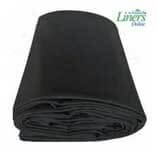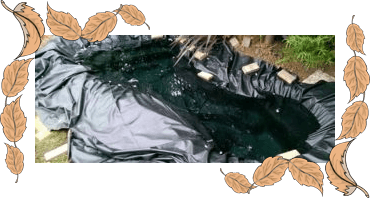Asking about pond liner thickness required for the size pond they are building then often follows in the pursuit for a successful pond guaranteed to give them a lifetime of enjoyment without any major maintenance.
The primary function of a pond liner is to give a water tight barrier to your pond thereby preventing water lose through ground seepage. A pond liner also provides a solid base for the pond either dug into the ground or a raised regular shaped pond. A high quality pond liner is designed to be durable, withstand adverse weather conditions, not perish due exposure to UV rays, be tear resistant to last for a number of years.
There are a three key types of pond liner you can choose from: rubber or PVC flat sheet pond liners, concrete and rigid pre-fabricated bases. The latter are normally constructed of fibreglass. While a prefabricated pond may seem a quick and reliable form of pond build, they can be difficult to handle and install plus they offer no scope of design flexibility. A concrete pond is prone to cracking due to ground movement. which then results in pond water leakage. A flat sheet pond liner is lightweight, durable and flexible with all the benefits of concrete, but with none of the hassle.
Rubber pond liners such as Butyl and Epalyn (EPDM) are now considered the most popular choice versus other pond lining materials. Flexible rubber pond liners are easy to install making them ideal for anybody constructing a pond regardless of experience.
The beauty of a flat sheet pond liner is that they are pliable enough to form into all the contours of your pond build, allowing them to fold and pleat over uneven ground and on marginal shelves.
Advantages of choosing Epalyn (EPDM) or Butyl pond liner:
- Flexible thereby offering you the freedom to let your imagination run wild. Rigid bases are normally of standard design and limit the design you can achieve. Concrete construction is expensive and although it does allow for original and unique designs its time consuming and a relatively difficult technique.
- The size, depths and shape of pond that a rubber pond liner allows you to create are only limited by the space that is available. It’s easy to create a pond habitat with varying depths.
- A rubber pond liner is easy to transport and handle. They can be cut to order or rolls of standard sizes can be bought. Handling and storage is straightforward. Although a little care needs to be taken with it, it is probably the most hassle free of the three materials.
- Epalyn (EPDM – Ethylene-Propylene-Diene Monomer) is available in varying thicknesses, and is the best choice for all pond installations, although a slightly more expensive option versus PVC pond liner. Epalyn is flexible and easy to work with, and conforms nicely even when twists and turns are involved in the pond installation.
What thickness of pond liner do I need?
Epalyn (EPDM) and Butyl pond liner come in a choice of thicknesses. Knowing whether to order 0.75mm, 0.85mm or 1.00mm is largely down to choice and type of pond build. But, the general recommendation is: 
- 0.75mm pond liner is recommended for most garden pond builds
- 0.85mm offers a little extra durability
- 1.00mm recommended for all box-welded pond liners fabricated for ornamental regular shaped ponds and flat sheet lined ponds where overlay protection is not suitable, but extra durability is required due to the type of planting, size of pond and exposure to visiting wildlife.
A rubber liner will normally come with a manufacturer’s guarantee of 25 years or longer. When laying your choice of flat sheet pond liner it’s important to remove sharp objects and stones from the earth. It is also sensible to lay a thin layer of sand or better still, a protective underlay such as Geotextile. Edges should be cut neatly and buried several inches below the surface surrounding the pond to give long-term protection from the claws of visiting wildlife and UV rays. PVC materials are less robust than rubber, which can withstand a good range of temperatures and are resistant to damage from UV light.
For details on what dimensions required for your pond or to place and order for a pond liner:







As a Newbie, I am continuously exploring online for articles that can benefit me. Thank you
You made certain fine points there. I did a search on the theme and found most people will agree with your blog.
Your home is valueble for me. Thanks!…
I appreciate reading your internet site. Appreciate it!
Christian Vieri http://ksbengineering.co.mz/index.php/component/k2/itemlist/user/228347
Surprisingly individual pleasant site. Huge details readily available on couple of clicks on
Luca Toni http://semika2000.com/?option=com_k2&view=itemlist&task=user&id=113591
You’ve very well knowlwdge in this case
Christian Vieri http://www.gongnu888666.com/comment/html/index.php?page=1&id=18688